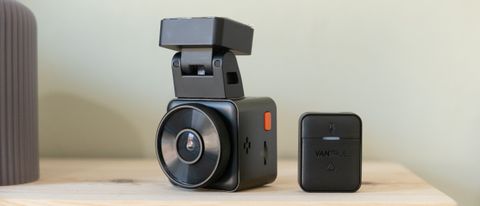TechRadar Verdict
The Vantrue E1 is a nicely designed and fairly compact dash cam with 2.5K video recording – or Full HD at double the frame rate – plus integrated GPS, Wi-Fi, and a wide, 160-degree lens. It also benefits from decent smartphone and computer applications, a magnetic quick-release windscreen mount, and an included remote control. Driving assistance systems are not present, a microSD card is not included in the box, and nor is Vantrue’s optional, £20 /$20 polarizing lens filter, which the E1 would benefit from.
Pros
- +
Good video quality
- +
Attractive, compact design
Cons
- -
2K only at 30fps
- -
No left/right adjustment
- -
Mac installation issues
Why you can trust TechRadar
Editor's Note
• Original review date: November 2022
• Launch price: From $179.99 / £149.99 / AU$ n/a
• Official price now: From $150 / £120 / AU$ n/a
Update: March 2024. Vantrue's E1 dash cam remains one of the best compact-sized dash cams, ideal for small cars and unobtrusive placement. Despite its diminiutive dimensions, it packs 2.5K video and a neat magnetic mount setup and connection. You'll still find it in our best dash cams guide, although the market is starting to fill with other small dash cams, you're not short of choice here. Now it's been available for some time, it's worth looking out for the E1 on sale, especially during an Amazon Prime Day when we've seen some heavy discounts.

Vantrue E1: two-minute review
Available in black, red, and blue, the Vantrue E1 is a compact dash cam that features a 2.5K resolution Sony Starvis sensor, voice commands, and an included remote control for manually recording footage. If you're looking for a good-value car camera that has built-in GPS smarts and a magnetic mount, it's one of the best dash cams around.
The E1's magnetic windscreen mount sticks to your screen in the normal way, but then connects to the E1 with a magnet that also carries a data and power connection. That way, the mount is plugged into your car’s 12v socket (or with the optional hardwiring kit), and the camera can easily be removed – handy for taking the E1 into the house to transfer footage, or hiding it if you’re concerned about it being stolen.
The magnetic mount works really well and serves as a secure but convenient way to attach and detach the dash cam. We do wonder, though, if the camera would stay in place after a heavy rear impact.
There’s a second USB-C port on the camera itself. This isn’t for power and is instead for transferring footage to a computer. It’s great that Vantrue is using USB-C, as all too often we find dash cam companies use microUSB or even the aged mini USB connection, making video transfer a pain if you misplace the included cable.
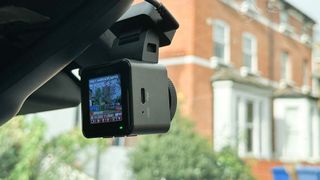
On the rear, there’s a tiny, 1.54-in display and the Vantrue E1's interface is navigated via three buttons on the bottom panel. The screen is just about large enough to help with installing the E1 in the right place, but after that, it serves as a distraction. Instead, you’re best going into the settings page of the Vantrue smartphone app, which connects to the camera via Wi-Fi and switching the display off. The same goes for a blinking green light that shows the E1 is recording.
There’s also an app for PC and Mac that shows precise locational and speed data captured with every video recording, thanks to the E1 having GPS. The app smartly shows exactly where you were on a map during each recording, along with movement on the X, Y, and Z axis of the E1’s G sensor.
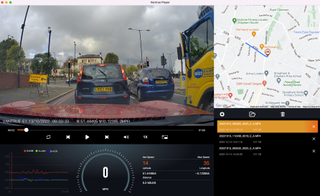
One thing to note with Vantrue’s Mac application is how we had to disable our Mac’s security to install the app, as it couldn’t be checked for malicious software. A Vantrue spokesperson said the company is arranging for its app to be available from Apple’s Mac App Store, but couldn’t offer a timeline for this.
Unusually, the Vantrue E1 comes bundled with a wireless remote control, which can be stuck to your dashboard and has two buttons for manually saving the most recent recording and turning the microphone on or off. Most drivers won’t need this, but if you drive a van or other vehicle with a tall windscreen, where the dash cam and its own buttons might be out of reach, the remote could be useful. Of course, the E1 also automatically saves recordings when it detects a collision.
By default, video is recorded in 2.5K, also known as 2592x1944. It can also record 2560x1440 with HDR, but both of these resolutions are limited to 30 frames per second. We preferred to use 1920x1080 because that is recorded at a smoother 60 frames per second, which retains more detail when paused or viewed slowly – in other words, when working out what caused a collision and who was at fault.
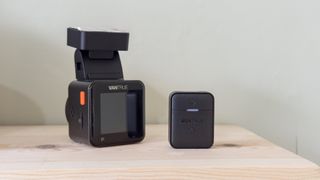
Detailed footage is recorded day and night, with accurate colors and acceptable levels of noise when recording in low light. The E1 would surely benefit from the polarizing filter offered by Vantrue as an optional extra; this screws onto the 160-degree lens and should remove most of the dashboard reflections that partially obscured recordings made on a sunny day.
The voice recognition system is convenient for taking photos, saving footage, and controlling the Wi-Fi and microphone without pressing buttons or reaching for your phone. This currently works in English, Chinese, Japanese, and Russian.
Should I buy the Vantrue E1?
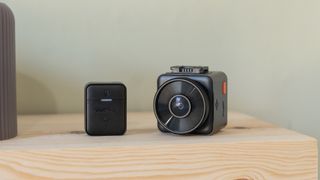
Buy it if...
You want GPS at a decent price
At $150 / £150, the E1 represents pretty good value, especially since it has integrated GPS that adds speed and locational data to your recordings. The inclusion of voice control and the optional remote also make it a good-value dash cam.
You drive a vehicle with a tall windscreen
This might sound niche, but we think van drivers will benefit from the E1’s included remote control, which makes it easy to manually save footage and control the microphone when the dash cam is out of reach – such as when it’s attached to the top of a high-roof van, motorhome or other large vehicles.
Your car already has driver assistance systems
Vantrue has correctly, in our opinion, decided not to fit the E1 with any driver assistance systems. Often including speed cameras and forward collision warnings, these systems are featured on many other dash cams but often fail to work reliably. They also feel like a waste when so many cars already have such a system of their own. We like how Vantrue has focused instead on the video quality, hardware, and software of the E1.
Don't buy it if...
You can’t mount a dash cam centrally
The E1’s magnetic mount works well, but its lack of side-to-side adjustment means it cannot be turned left or right. If you can’t mount the dash cam in the centre of your screen, because of the rear-view mirror or car’s forward-facing cameras and driver assistance system, the E1 has to be angled awkwardly from one side, producing slanted footage. A ball-and-socket joint would be better.
You expect a polarizing lens to be included
Some dash cams include a small polarizing lens in the box, but for the Vantrue E1 this isn’t the case. Instead, you’ll have to pay extra for the accessory, which screws onto the front and promises to cut down on dashboard reflections obscuring footage in bright sunlight.
You haven’t already got a microSD card
Another item missing from the box is a microSD card, so you’ll have to provide your own. Somewhat making up for this is how the E1 supports cards up to 512GB, which is larger than many other dash cams we’ve used. And in any case, they tend to only come with cards of 32GB capacity, so having the option to buy your own, much larger one isn’t such a hardship. Ultimately, the E1 still feels like good value for money.
Alistair Charlton is a freelance technology and automotive journalist based in London. His career began with a stint of work experience at TechRadar back in 2010, before gaining a journalism degree and working in the industry ever since. A lifelong car and tech enthusiast, Alistair writes for a wide range of publications across the consumer technology and automotive sectors. As well as reviewing dash cams for TechRadar, he also has bylines at Wired, T3, Forbes, Stuff, The Independent, SlashGear and Grand Designs Magazine, among others.
